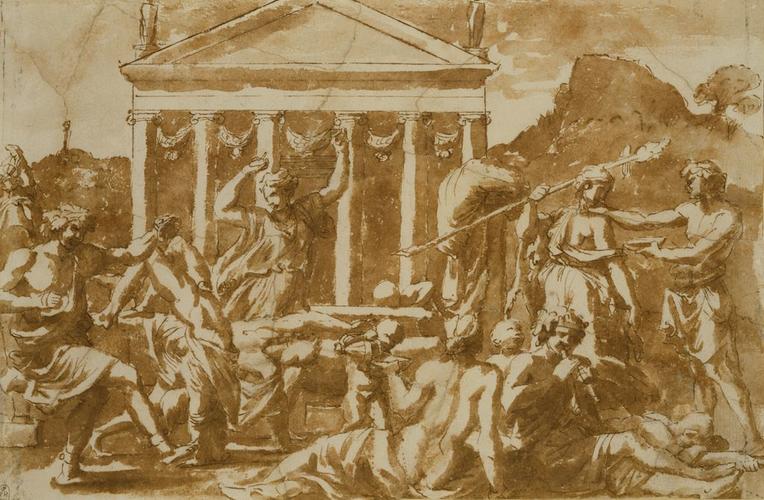-
1 of 253523 objects
A Ritual Dance before a Temple c.1636-37
Slight black chalk underdrawing, pen and brown ink, brown wash | 20.8 x 31.4 cm (sheet of paper) | RCIN 911910
-
A drawing of a Bacchic revel before a classical temple. The Massimi manuscript catalogue identifies the subject as the Mysteries of Priapus, and several prints of the sixteenth century depict the rites of that god - one of which, after a design by Giulio Romano, was used by Poussin as the basis for his Dance in Honour of Priapus (São Paulo). But apart from the ithyphallic figure at the far right, and a sketchily drawn object held by the central dancer that might be a votive phallus, there is nothing to support the identification of the subject as a Priapic ceremony rather than a generalised ritual dance before a temple.
This drawing and another at Chantilly (Rosenberg & Prat 1994, no. 97) are related to a lost painting by Poussin known through copies (eg. M.H. de Young Memorial Museum, San Francisco). Although the Chantilly drawing is more loosely drawn than the present sheet, it is closer in detail to the painted composition, differing only in the form of the temple and the presence of a herm at the right side of the drawing. The weaknesses of the Windsor drawing are plain to see, for the design splits between the wild actions of the four revellers at the left and the rather static poses of those at the right; in the Chantilly drawing Poussin reduced the number of figures and unified them in a closed oval composition. The bold pen and wash of the drawings is typical of the mid-late 1630s, but scholarly consensus has placed the lost painting considerably later, the bulbous figures and carefully contrived space evident even in the copies suggesting a date around 1650. Perhaps this is another example of a patron requesting a painting to the design of a pre-existing drawing.The drawing has two unusual features. Most obviously, it has been deliberately torn up, and repaired using corn paste, a typically seventeenth-century adhesive. As the drawing came from the collection of Cardinal Massimi, and was surely not damaged in such a way after entering his possession, it was presumably Poussin himself who frustratedly tore up a drawing with which he was unhappy. The earliest definite link between Poussin and Massimi is the collaboration over the illustrations to the 1640 edition of Barberino's Documenti d'Amore (see RCIN 911921, 911967-8); but the disputed self-portrait drawing in the British Museum states that Massimi took drawing lessons from Poussin, and as Massimi was born in 1620, they may well have been acquainted from the mid-1630s. This would accord with the date of the present drawing, and one can imagine the fragments being retrieved by the young Massimi from the studio floor and pieced back together for his embryonic collection. The lower half of 911997 has been deliberately damaged and repaired in a similar way, a sheet that also came from Massimi's collection.
The other oddity is the series of dotted ink lines across the lower part of the composition. Passing right across the drawing, a third of the way up, is the horizon line, emphasizing the unusually low viewpoint of the composition. Three lines radiating from a central point could be assumed to be perspectival, but they and a shallow diagonal across the lower right corner appear irrelevant to the construction of the picture. Similar lines are occasionally found in on Poussin's drawings and paintings from the mid-1630s to the late 1640s, such as a set of roughly vertical stylus lines in the centre of 911995, and the dark lines visible under the paint of the Louvre Rape of the Sabine Women; but their use is far from systematic and in this case cannot be explained.Provenance
Cardinal Camillo Massimi (1620-1677); from whose heirs bought in 1739, for 300 scudi, by Richard Mead (1673-1754); probably presented to Frederick, Prince of Wales, by 1750.
-
Creator(s)
Acquirer(s)
-
Medium and techniques
Slight black chalk underdrawing, pen and brown ink, brown wash
Measurements
20.8 x 31.4 cm (sheet of paper)
Category
Object type(s)
Other number(s)
RL 11910Alternative title(s)
Li Misteri di Priapo

